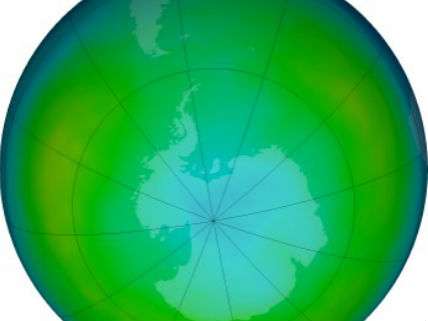Ozone Hole Over Antarctica Is Closing, Reports Science
The phase out of ozone-damaging chlorofluorocarbon refrigerants is working

In the 1980s, researchers discovered that the protective stratospheric ozone layer over Antarctica was thinning. Since stratospheric ozone reduces the amount of damaging ultraviolet light from the sun that reaches the surface, this was potentially very bad news. Scientists quickly identified chlorofluorocarbons (CFCs) widely used as coolants in refrigerators, air conditioners, and as propellants in spray cans as the culprits. CFC molecules floated into the stratosphere where they destroyed ozone molecules. Environmental activist Al Gore famously, but inaccurately, asserted that rabbits and fish in Argentina were being blinded by increased ultraviolet light as a result of the thinning ozone layer. In 1987, countries producing CFCs agreed in the Montreal Protocol to phase out CFCs.
In my 1993 book, Eco-Scam I reported on the science and politics related to the problem of the ozone layer and concluded that an international ban on CFCs was merited. From Eco-Scam:
Despite a great deal of continuing scientific uncertainty, it appears that CFCs do contribute to the creation of the Antarctic ozone hole and perhaps a tiny amount of global ozone depletion. If CFCs were allowed to build up in the atmosphere during the next century, ozone depletion might eventually entail significant costs. More ultraviolet light reaching the surface would require adaptation-switching to new crop varieties, for example-and it might boost the incidence of nonfatal skin cancer. In light of these costs, it makes sense to phase out the use of CFCs. …
The normal processes of science and democratic decision-making have proved adequate to correct what might have become a significant problem. In 1990 our national and international institutions hammered out an agreement to control CFCs, the London Agreement to the Montreal Protocol, which takes the interests of all affected groups into account (though imperfectly).
This is in line with my general view that wherever anyone identifies something as an environmental problem, that problem is occurring in an open-access commons. There are two things one can do to address such problems; assign property rights (the preferred policy) or regulate the commons. Since atmospheric pollution presents significant barriers to assigning property rights, I concluded that the international treaty banning CFCs was the appropriate response.
So the good news reported in Science this week is that ozone layer over Antarctica is in the process of healing:
Industrial chlorofluorocarbons that cause ozone depletion have been phased out under the Montreal Protocol. A chemically-driven increase in polar ozone (or "healing") is expected in response to this historic agreement. Observations and model calculations taken together indicate that the onset of healing of Antarctic ozone loss has now emerged in September. Fingerprints of September healing since 2000 are identified through (i) increases in ozone column amounts, (ii) changes in the vertical profile of ozone concentration, and (iii) decreases in the areal extent of the ozone hole. Along with chemistry, dynamical and temperature changes contribute to the healing, but could represent feedbacks to chemistry. Volcanic eruptions episodically interfere with healing, particularly during 2015 (when a record October ozone hole occurred following the Calbuco eruption).
Amusingly whoever curates my wikipedia entry continues to assert: "In his 1993 book, Ecoscam, and other works, Bailey criticized claims that CFCs contribute to ozone depletion and that human activity was contributing to global warming." Oh, well.


Show Comments (77)